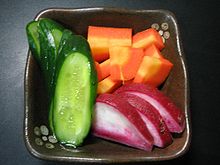Tsukemono
Tsukemono ( Japanese 漬 物 , actually German in the narrower sense of fragrant things ) is pickled vegetables in Japanese cuisine . It is used as a side dish ( okazu ) for rice as snacks to beverages ( otsumami ), or sometimes known as Kaiseki -Menügang for Japanese tea ceremony served.
The usual types of tsukemono are vegetables pickled in table salt . Soy sauce ( shoyu ), miso ( miso ), vinegar ( suzuke ), rice bran ( nuka ) and rice wine ( sake ) are used as condiments for some types. Frequently used vegetables are Daikon radish - an Asian breed form of garden radish Raphanus sativus L . - or radish , Ume plum (one of apricot ), Chinese cabbage and cucumber . Traditionally, the Japanese make Tsukemono in a Tsukemonoki ( 漬 物 器 , dt. "Vessel for pickled") - a vessel made of wood, stoneware or ceramic - today these vessels are also made of plastic or glass, as inserting is one of the usual ways to preserve Food was. Today tsukemono are available in every supermarket , but many Japanese still make them themselves.
The production corresponds to that of the world-famous sauerkraut : chopping, filling into a container alternating with salt, weighing down, (controlled) fermentation, shelf life in the absence of air. In Japan you usually use a tsukemonoki , salt and a weight to weigh down. Originally, the necessary pressure was exerted through a wedge between the handle of the vessel and a round disc lying on the vegetables. Today one takes 1–2 kg heavy stones or metal weights ( Tsukemonoishi 漬 物 石 , dt. "Stone for pickled"), often with a handle and with a food-safe plastic coating. Other modern variants consist of a plastic vessel, the pressure is exerted by a screw spindle.
The process is based on lactic acid fermentation (analogous to sauerkraut). However, while this only describes one type of vegetable ( white cabbage ), Tsukemono describes a variety of types and mixtures of vegetables that are preserved in this way.
Types of tsukemono preparation
The basis is always an addition of table salt to fresh, processed vegetables and the subsequent lactic acid fermentation. This is brought about in the absence of air. Added seasonings must not hinder this lactic acid fermentation to such an extent that it is delayed to such an extent that the inevitable supply of oxygen during fermentation causes mold to form. Analogous to the sauerkraut, a shelf life of several months is given after the fermentation is complete and if the air is further excluded.
| Art | Kanji | Condiments | comment |
|---|---|---|---|
| Shiozuke | 塩 漬 け | just brine | - |
| Asazuke | 浅 漬 け | just brine | short preparation time |
| Shoyuzuke | 醤 油漬 け | soy sauce | - |
| Misozuke | 味噌 漬 け | Miso | - |
| Suzuke | 酢 漬 け | vinegar | - |
| Nukazuke | 糠 漬 け | Rice bran | - |
| Kasuzuke | 粕 漬 け | Rice Wine - Gelager | Dregs upon Sakeherstellung |
| Shio koji | 塩 麹 | Brine , rice , koji culture | - |
| Karashizuke | か ら し 漬 け | Mustard seed | - |
| Amasuzuke | 甘 酢 漬 け | Sugar , vinegar | - |
| Satozuke | 砂糖 漬 け | sugar | - |
Source for the table:
Known Tsukemono
- Beni shōga
- Bettarazuke
- Fukujinzuke
- Furuzuke
- Gari
- Hakusaizuke
- Matsumaezuke
- Narazuke
- Nozawana
- Senmaizuke
- Shibazuke
- Takuan
- Wasabizuke
- Umeboshi
- Rakkyozuke
literature
- Hisamatsu, Ikuko: Tsukemono Japanese Pickling Recipes . Japan Publications Trading Co., LTD. and Boutique-sha, Inc., Japan 2013, ISBN 978-4-88996-181-2 , pp. 6 (English).
See also
Web links
- Tsukemono (Japanese)
- Tsukemono (English)
- Pickles from Europe and USA (Japanese)
Individual evidence
- ↑ Libby Reid: 漬 物 - Tsukemono: A Look at Japanese Pickling Techniques - Kanagawa International Foundation. ( PDF ; 972kB) In: kia.or.jp. August 2008, accessed September 30, 2019 (English, Japan Cultural Research Project, Kanagawa Prefecture - State of Maryland Sister State Program).

